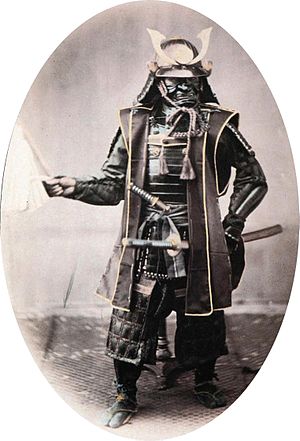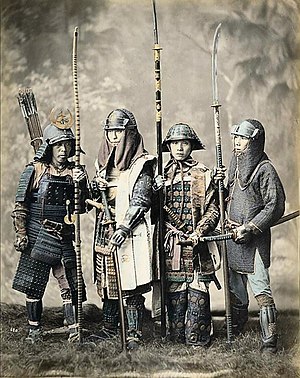|
Vikidia currently has 4,621 articles. Improve it! |
|
Join Vikidia: create your account now and improve it! |
Samurai
The samurai (or bushi) were Japanese warriors. The word samurai comes from the Japanese Verb saburai, which means to serve (someone). In the past, there were many different Classes of people in Japan. "Samurai" were members of the important Military Class before Japanese society changed in 1868.
History[edit | edit source]
During the chaotic Era of Warring States (sengoku jidai, 1467-1573), Japan was made up of dozens of independent states which were constantly fighting each other. This is why the country needed lots of samurai. Between the wars, many samurai were working on farms. Many of the famous samurai movies by Akira Kurosawa take place during this era.
In the Twelfth Century, two military clans named the Minamoto and Taira had become very powerful. These clans controlled much of Japan. The Minamoto and Taira clans also fought wars against each other. The Minamoto Yoritomo started a new government in Kamakura in 1192. As shogun, the highest military officer, he became the ruler of Japan.
Toyotomi Hideyoshi (1536 or 1537-1598) won many wars against other clans. When he reunited Japan, Hideyoshi developed a very strict social caste system. It was later completed by Tokugawa Ieyasu and the rulers after him. Between the wars, many samurai had always worked on farms. Hideyoshi forced all samurai to decide between a life on the farm and a warrior life in castle towns. Furthermore, he made it a law that the samurai were the only people who were allowed to arm themselves with a sword.
In the Edo period (1603-1867), the samurai were the most important social Caste, followed by the farmers, artisans and merchants. All samurai had to live in Castle towns. The samurais' Lords paid them with rice. Some samurai did not have Lords. These samurai were called "ronin". The "ronin" caused some problems for Japan in the early Edo period.
In 1615, Tokugawa won an important battle when he took Osaka Castle. The Tokugawa clan did not have any more Rivals. Japan became very peaceful for about 250 years. In these 250 years, military skills became less important. Most samurai became bureaucrats, teachers or artists.
In 1868, feudalism ended in Japan. This was the end of the samurai class.
Weapons[edit | edit source]
- Japanese swords are the weapons that most people connect with samurai. Ancient Japanese swords from the Nara period (Chokutō) featured a straight blade, by the late 900s curved tachi appeared, followed by the uchigatana and ultimately the katana. Smaller commonly known companion swords are the wakizashi and the tantō.[1] Wearing a long sword (katana) or (tachi) together with a smaller sword such as a wakizashi or tantō became the symbol of the samurai, this combination of swords is referred to as a daishō (literally "big and small"). During the Edo period only samurai were allowed to wear a daisho.
- The yumi (longbow) was a major weapon of the Japanese military. Use of the Yumi became less common when samurai began to use the "tanegashima" (Japanese matchlock) in the Sengoku period. But many samurai continued to use the Yumi for sport.[2] The yumi was an uneven composite bow made from bamboo, wood, rattan and leather. A yumi could hit a target 50 or 100 meters away. or 100 meters away. On foot, it was usually used behind a tate (手盾), a large, mobile wooden shield, but the yumi could also be used from horseback because of its asymmetric shape. The practice of shooting from horseback became a Shinto ceremony known as yabusame (流鏑馬).[3]
- Pole weapons including the yari and naginata were commonly used by the samurai. The yari (Japanese spear) displaced the naginata from the battlefield as personal bravery became less of a factor and battles became more organized around massed, inexpensive foot troops (ashigaru). A charge, mounted or dismounted, was also more effective when using a spear rather than a sword, as it offered better than even odds against a samurai using a sword. In the Battle of Shizugatake where Shibata Katsuie was defeated by Toyotomi Hideyoshi, then known as Hashiba Hideyoshi, seven samurai who came to be known as the "Seven Spears of Shizugatake" (賤ヶ岳七本槍) played a crucial role in the victory.[4]
- Tanegashima (Japanese matchlock) were introduced to Japan in the 1543 through Portuguese trade. Tanegashima were produced on a large scale by Japanese gunsmiths, enabling warlords to raise and train armies from masses of peasants. The new weapons were highly effective, their ease of use and deadly effectiveness led to the tanegashima becoming the weapon of choice over the yumi (bow). By the end of the 16th century, there were more firearms in Japan than in many European nations. Tanegashima—employed en masse, largely by ashigaru peasant foot troops—were responsible for a change in military tactics that eventually led to establishment of the Tokugawa shogunate (Edo period) and an end to civil war. Production of tanegashima declined sharply as there was no need for massive amounts of firearms. During the Edo period, tanegashima were stored away, and used mainly for hunting and target practice. Foreign intervention in the 1800s renewed interest in firearms—but the tanegashima was outdated by then, and various samurai factions purchased more modern firearms from European sources.
- Cannons became a common part of the samurai's armory in the 1570s. They often were mounted in castles or on ships, being used more as anti-personnel weapons than against castle walls or the like, though in the siege of Nagashino castle (1575) a cannon was used to good effect against an enemy siegetower. The first popular cannon in Japan were swivel-breech loaders nicknamed kunikuzushi or "province destroyers". Kunikuzushi weighed 120 kg and used 18 kg chambers, firing a small shot of 280 g. The Arima clan of Kyushu used guns like this at the Battle of Okinawate against the Ryūzōji clan. By the time of the Osaka campaign (1614–1615), cannon technology had improved in Japan to the point where at Osaka, Ii Naotaka managed to fire an 8.2 kg. shot into the castle's keep.
- Staff weapons of many shapes and sizes made from oak and other hard woods were also used by the samurai, commonly known ones include the bō, the jō, the hanbo, and the tanbo.
- Clubs and truncheons made of iron and/or wood, of all shapes and sizes were used by the samurai. Some like the jutte were one-handed weapons and others like the kanabo were large two-handed weapons.
- Chain weapons, various weapons using chains kusari were used during the samurai era, the kusarigama and Kusari-fundo are examples.
Beliefs[edit | edit source]
A samurai believed that his swords hold his soul, so they became the most important thing he had.
Samurai were allowed to fight anyone who did not show them proper respect. Every sword had to be tested; to do this, the owner of the sword could execute a criminal. This allowed the warrior to test his sword's sharpness. Samurai led their lives according to the ethic code of bushido, which translates as "the way of the warrior". This signifies loyalty to one's master, self-discipline and respectful, ethical behaviour from visitors to enemies on the battlefield. When a samurai lost his master, also called Daimyo, he became a Ronin.
After a defeat or the samurai dishonored himself by not following the code of bushido, the samurai must commit ritual suicide, which is called Seppuku. To a samurai, death was better than having no honour. In Seppuku, samurai cut their stomach before the enemy could capture them, in the case of a war. In Europe, this ritual is often mistaken for hara-kiri. Hara-kiri means "to cut the stomach". In other words, hara-kiri refers only to the action done by Seppuku and not the whole ritual. Seppuku was thought to be a more honourable death for a samurai than being captured by the enemy. Another reason to commit Seppuku was the death of the Daimyo. With this ritual, a samurai was able to show how loyal he was to his dead master. There were periods when Seppuku was forbidden, but there were still samurai who committed it.
The bushi's training methods like meditation, judo and kendo are still followed today. Although there is no longer a samurai class in modern Japan, the successors of these families are well-respected.
Samurai and women[edit | edit source]
It has to be noted that the term "Samurai" is a gender-specific term, referring to males specifically. An academic article on this can be found here
Japanese women had a very clear role in Japanese society. Most of them took care of house and crops and raising children. There were a few women who were samurai. One of the most famous Japanese samurai women was Itagaki. She lived during the end of the Heian period (794 – 1192) and owned her own army of about 3000 warriors. In 1199, Itagaki fought against 10.000 Heike soldiers. She was very good at handling the naginata sword, which made her very famous.
Samurai women were also trained to defend themselves and their children. They usually did this while their warrior husbands were busy in battles. The samurai wife was called okusan (in translation "one who remains at home"). This is why samurai women were trained to handle polearms (naginata) and short daggers (Tanto). During the Edo period (1600-1800 AD), Japanese women were trained to handle naginata by the age of 18. The short kaiken knife was used by young women to defend their virtue or, if they lost it, to take their own life.
The Japanese women, especially the samurai wives, were very respected. They had qualities that made them an important part of Japanese society. They were obedient, self-controlled, loyal, responsible, etc. Wives of rich samurai were very well dressed and enjoyed a good position in society. They did not do any physical work. However, no women were allowed to be involve in politics or warfare.
Of course, there were women who were powerful. For example, in Muromachi period, the wife of Ashikaga Yoshimasa (1449 – 1474, 8th shogun), Hino Tomiko ruled in his place. The Toyotomi Hideyoshi's (1536 – 1598) mistress became the real master of Osaka castle after his death. Yamauchi Kazutoyo's (1545 – 1605) wife, Chiyo, was one of the most loyal wives known in Japanese history. Her power was of another kind, she supported her husband during hard times, saving to buy a horse for him. Yamauchi Kazutoyo never took a mistress, though it was a known tradition for samurai, and he never left Chiyo although she was only able to have one child (a girl, Yone).
During Tokugawa Era (1603 – 1867) women's education became very important. Girls were taught to write, read, dance, etc. beginning at a young age. While the main criteria for marriage changed, among the most important were: physical attractiveness and education. Special books were written for women. They mainly taught how to take care of house and children. But, by the end of the Tokugawa period women attended philosophical and literary classes.
Other pages[edit | edit source]
References[edit | edit source]
- ↑ Karl F. Friday (2004). Samurai, warfare and the state in early medieval Japan. Psychology Press. pp. 78–80. ISBN 978-0-415-32963-7. http://books.google.com/books?id=q5KBjpGSRgkC&pg=PA78. Retrieved 5 November 2011.
- ↑ Kathleen Haywood; Catherine Lewis (2006). Archery: steps to success. Human Kinetics. pp. 10–. ISBN 978-0-7360-5542-0. http://books.google.com/books?id=-EFySHOgGmIC&pg=PR10. Retrieved 9 April 2011.
- ↑ Thomas Louis; Tommy Ito (5 August 2008). Samurai: The Code of the Warrior. Sterling Publishing Company, Inc.. pp. 117–. ISBN 978-1-4027-6312-0. http://books.google.com/books?id=wExlaM1ov0sC&pg=PA117. Retrieved 9 April 2011.
- ↑ Turnbull, Stephen R. (11 April 2008). The Samurai Swordsman: Master of War. Tuttle Publishing. pp. 65–. ISBN 978-4-8053-0956-8. http://books.google.com/books?id=NR9j09T2hLkC&pg=PA65. Retrieved 9 April 2011.
Other websites[edit | edit source]

|
History Portal — All articles about history. |




